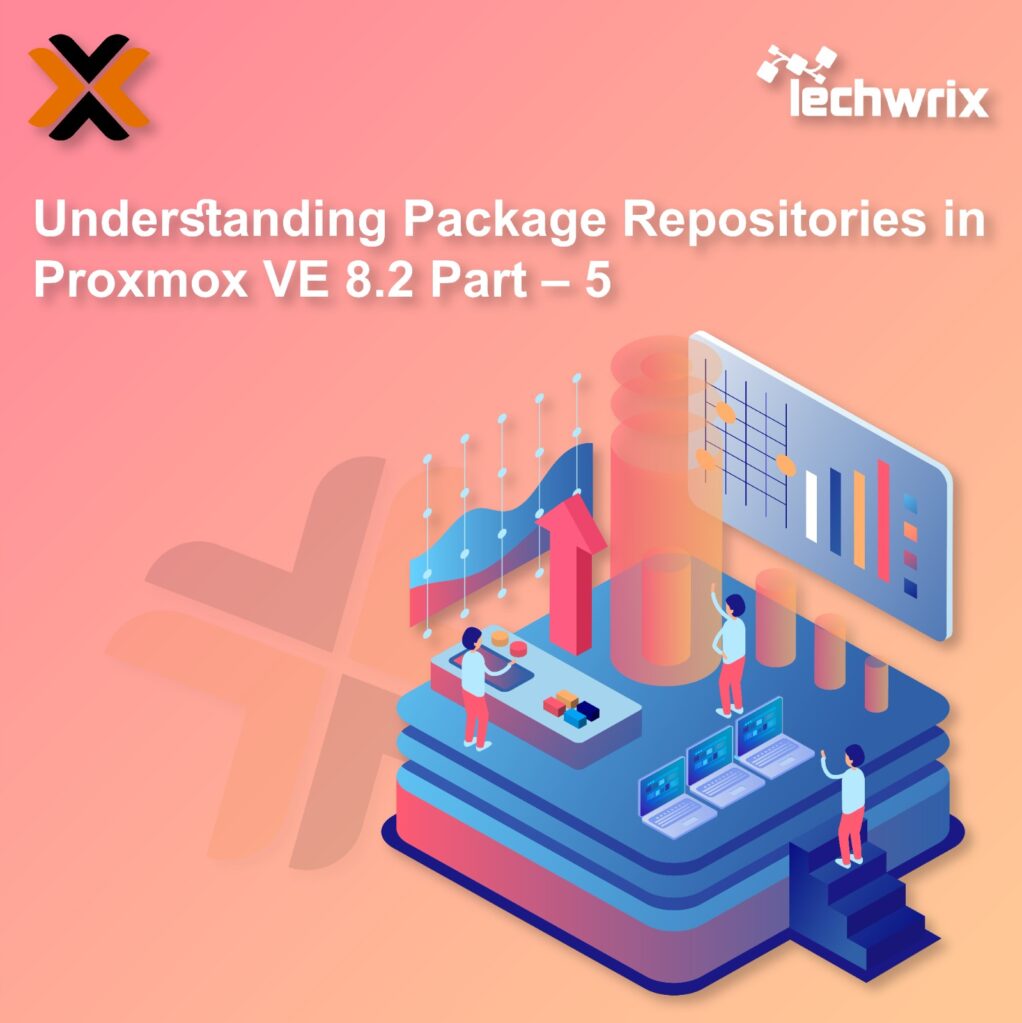Understanding Package Repositories in Proxmox VE 8.2 Part – 5
Proxmox VE is a powerful reliable open-source solution built for enterprise virtualization environments. A Virtualization Engineer aiming to improve IT infrastructure should understand the complexity of Proxmox VE.
An essential component of administering Proxmox VE is its package repositories. These repositories are essential for preserving and upgrading your virtualization environment, guaranteeing security, stability, and access to the latest features. This article will explore the different package repositories offered in Proxmox VE 8.2.
If you missed previous blog posts of this series, you can find them here:
Introduction to Proxmox VE 8.1
Installing Proxmox VE 8.1 on VMware Workstation 17
Proxmox VE 8.1: Overview of Web Console
Containers vs. VMs: Choosing the Right Approach for Your Proxmox VE – Part 4
Understanding Package Repositories
Package repositories are centralized storage locations from which software packages can be retrieved, installed, and updated. These repositories ensure that your system has access to the latest features, security patches, and bug fixes, thereby maintaining the stability and security of your Proxmox virtualization platform.
In the context of Proxmox VE, there are several types of repositories, each serving different needs:
Enterprise Repository
The Enterprise Repository is available to users with a valid Proxmox VE subscription. It provides access to thoroughly tested and stable packages, ensuring the highest level of reliability for production environments.
This repository is ideal for enterprises that prioritize stability and are willing to invest in a subscription to minimize risks and downtime.
No Subscription Repository
The No Subscription Repository, also known as the Community Repository, is available to all users, regardless of subscription status. This repository provides access to the same software packages as the Enterprise Repository but without the same level of testing and support.
It is a valuable resource for users who want to stay updated with the latest features and improvements without the cost of a subscription. However, it requires users to be more proactive in managing and troubleshooting their Proxmox VE installations.
Test Repository
The Test Repository is intended for users who want to access the latest developments and experimental features in Proxmox VE. Packages in this repository are not as thoroughly tested as those in the Enterprise or No Subscription repositories and may contain bugs or unfinished features. This repository is best suited for development environments or for users who want to contribute to the testing and improvement of Proxmox VE.
Understanding the differences between these repositories allows you to make informed decisions about how to configure your Proxmox VE system based on your specific needs and risk tolerance.
Overview of Proxmox VE 8.2
Proxmox Virtual Environment (VE) 8.2, released on April 24, 2024, introduces a range of enhancements designed to improve installation, management, and performance. This release ensures that your virtualization environment remains at the cutting edge of technology. Here are the key updates in Proxmox VE 8.2:
Automated Installation: Proxmox VE 8.2 supports automated and unattended installations, simplifying the deployment process for large-scale environments.
VM Import Wizard: A new wizard facilitates the import of virtual machines (VMs) from VMware ESXi, making it easier to migrate existing workloads to Proxmox VE.
nftables Firewall: The firewall system has been updated to use nftables, providing enhanced security and more robust firewall management capabilities.
Device Passthrough for LXC: Proxmox VE 8.2 includes support for device passthrough in LXC containers, allowing for greater flexibility and performance in containerized environments.
Enhanced Backup Options: New advanced backup settings offer greater control over backup processes, improving data protection and recovery options.
Custom CAs: The release adds support for custom Certificate Authority (CA) configurations with ACME, enhancing SSL/TLS certificate management and security.
User Interface Enhancements: Proxmox VE 8.2 features several UI improvements, making the platform more user-friendly and intuitive. Enhanced dashboards and streamlined navigation help administrators manage their environments more efficiently.
Debian 12.5 (Bookworm): Proxmox VE 8.2 is based on Debian 12.5, ensuring compatibility with the latest software packages and updates.
Linux Kernel 6.8: The inclusion of a newer Linux kernel (6.8) provides improved performance, hardware compatibility, and security features.
QEMU 8.1: Updated to QEMU 8.1, offering better performance and new features for virtual machine management.
Ceph Reef 18.2: The latest version of Ceph (Reef 18.2) provides enhanced scalability and stability for distributed storage solutions.
LXC 6.0: Updated LXC version 6.0 improves container management and performance.
Open ZFS 2.2: Open ZFS 2.2 brings advanced storage capabilities, improving data integrity and performance for ZFS file systems.
These enhancements in Proxmox VE 8.2 underscore the importance of keeping your system updated to leverage the latest features and improvements.
Conclusion
Maintaining a well-configured and up-to-date Proxmox VE environment is essential for ensuring the stability, security, and performance of your virtualization infrastructure. By understanding the different package repositories and configuring the No Subscription Repository, you can keep your Proxmox VE 8.2 system current without the need for a paid subscription. This guide has provided you with a comprehensive overview of the steps involved, along with best practices and troubleshooting tips to help you manage your environment effectively.
In summary, we have covered:
Understanding Package Repositories: The role of package repositories in Proxmox VE and the differences between Enterprise, No Subscription, and Test repositories.
Overview of Proxmox VE 8.2: Key features and improvements in the latest release, highlighting the importance of keeping your system updated.
Proxmox VE Subscription Model: An overview of the subscription tiers and the benefits of each, helping you make informed decisions about repository configurations.
By following this guide, you can ensure that your Proxmox VE setup remains robust and efficient, providing a reliable foundation for your virtualization needs.
We hope you found this guide helpful and informative. Please share your experiences, tips, and questions in the comments section below. Your feedback and insights are valuable to us and can help others in the Proxmox VE community.
